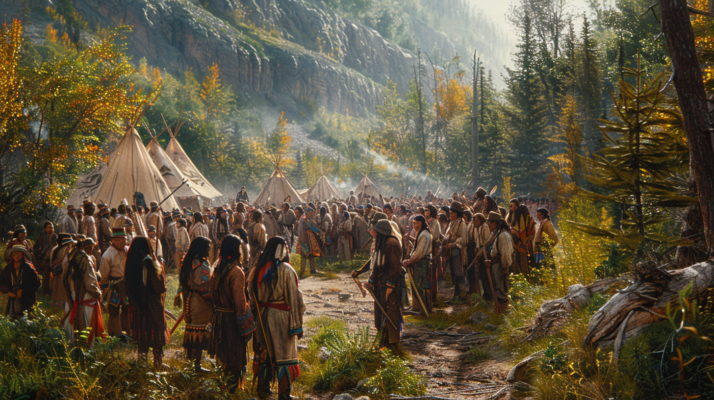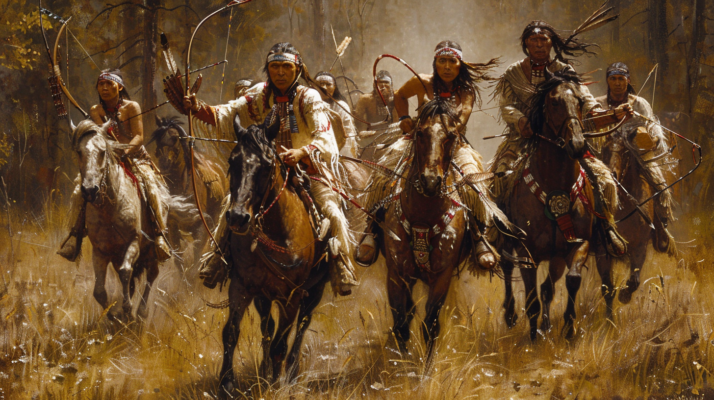As General Custer made his final stand against the united Lakota Sioux and Cheyenne warriors, the way the dead were handled at Little Bighorn offers a revealing look at the era’s views on life, death, and the respect given to those who perished on the battlefield. The bodies, left exposed to natural and human elements, narrate the gruesome tale of one of the most notorious battles in the American-Indian Wars. Bighorn County, Montana, 1876.
Even after two centuries of expansion, settlement, and warfare, conflict persisted between native tribes and the new Americans. The Plains Indians, particularly, posed a significant challenge to American expansion. Tribes like the Apache, Comanche, Cheyenne, and others, known for their warrior prowess and exceptional horsemanship, often acted in small warbands armed with bows, tomahawks, and limited firearms. These tribes could inflict serious damage not only on untrained settlers but also on professional American soldiers. Their fierce, unwavering nature made them a formidable threat to American authority.
In 1851, the Fort Laramie Treaty was signed to stop intertribal wars and protect white settlers and American interests. The treaty defined the lands owned by eight native tribes and clearly marked their territories to prevent expansion. It also ensured the safe passage of travelers through the Oregon Trail and the construction of roads and forts. However, conflict re-emerged as tribes trespassed on each other’s land in search of buffalo, and things worsened after gold was discovered on Indian lands. Settlers, despite the treaty, established settlements, and American authorities made little effort to prevent these breaches, fueling resentment among all parties involved.

By 1866, the United States was forced to act, leading to Red Cloud’s War, which lasted two years and resulted in the deaths of 200 American soldiers and civilians and an unknown number of Indians. After the war, the Second Treaty of Fort Laramie was signed but was almost immediately broken by encroaching white gold miners. The U.S. government pressured the Lakota to sign away their rights to the Black Hills, an area rich in resources. Resentment grew as the Lakota were continuously pressured to give up their land. Two prominent native war chiefs, Sitting Bull and Crazy Horse, pushed for armed resistance, and many tribes of Sioux and Cheyenne joined them, aware of the broken promises from the Americans.
On June 22nd, 1876, Custer and his men were sent out from the main expeditionary force as scouts. By the early morning of the 25th, they had located a native encampment 14 miles east of the Little Bighorn River. A surprise attack was planned for the next day until one of Custer’s scouts informed him that an enemy warband had discovered their trail. The decision was made to attack immediately before the hostile force could catch up. Custer split his 700 men into three groups: one to prevent the escape of natives from the south, one to charge the village directly, and the last, commanded by Custer, to attack from the north.
The attack began around midday as Custer and his men entered the Little Bighorn Valley. Chief Sitting Bull ensured the safety of the women and children while Crazy Horse confronted Custer. American intelligence had underestimated the number of warriors in the encampment, which was actually 2,000, many equipped with rapid repeating rifles compared to the Americans’ single-shot Springfields. Custer and his 210 men were quickly surrounded and cut off from their allies. The fight lasted less than an hour, ending with the defense of Last Stand Hill and the total annihilation of Custer and his men.

As no man survived to tell the true tale of Custer’s Last Stand, the exact story remains unknown. Later, native accounts, passed down through generations, tend to be conflicting. Custer’s native Crow Scout, Ashishisha, gave a vague retelling of the battle, saying Custer attacked the village head-on but was quickly driven back to Last Stand Hill, where he and his men met their demise. The other two groups did not learn of Custer’s defeat until two days later and found only the 210 American dead on the battlefield. Captain Frederick Benteen deduced it was a rout and panic until the last man was killed.
The American bodies had been stripped of their clothing and useful possessions, and viciously mutilated. Soldiers had their trigger fingers removed to prevent them from fighting in the afterlife, while Custer had knitting needles forced into his ears and an arrow stabbed into his genitals. The bodies were hastily buried in shallow graves due to the limited number of digging tools. Custer’s grave was the most prestigious, 18 inches deep, marked with stakes and his name written on a piece of paper rolled into a spent cartridge case. It seemed he had been shot in the heart and another shot in the head, likely after his death.

Calls to return to the battlefield and properly bury the bodies grew within the year. Lieutenant General Sheridan contacted General Sherman to authorize the necessary expenses. Although initially refused, permission was eventually granted. Soldiers found the site littered with decomposed bodies, eaten by wild animals. Officers’ remains were identified and reburied at a nearby army fort, while enlisted men’s remains were buried in more suitable graves marked with stakes. However, the Montana rainy season soon washed away the loose soil, exposing the remains again.
The battle was a brief but significant victory for the Lakota and Cheyenne, but they knew they had not won the war. Both the public and the U.S. government rallied around Custer and his men, immortalizing them as brave warriors. A large force of American soldiers was sent to subdue the native tribes, occupying their land and hunting grounds. Within a year, most native warriors surrendered, unwilling to continue the fight. The Black Hills were taken by the United States with no compensation, and the area was flooded with gold miners, generating tremendous wealth.



